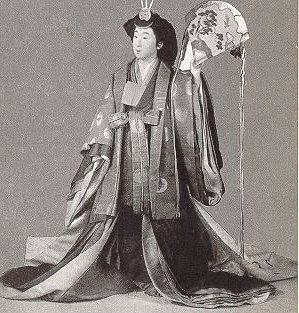
Kimono History: The Heian era
During the Heian era the powers of the emperors weakened and relationships with China were suspended which resulted in a time when the Japanese could develop their own artistic sense.
The Chinese fashion of rich brocades for ceremonial robes changed for the most part to an attire of heavy layers of kimono. Small, regular woven designs became the style. A glimpse of many shades of color at the neck, sleeve and hemline was the sought-after effect, with subtle gradations of the color scheme according to the seasons.
The court nobles during the time wore long trailing robes called sokutai. The sleeves were large and open at the end. Under this outer robe was an undergarment called the kosode which was the forerunner of the modern kimono. Male aristocrats wore the noshi, an official garb of court nobles, and the kariginu, a more informal dress for everyday use. Both types of clothing were loose fitting, very large and had long sleeves which hung to the knees.
They might also wear hakama, or long baggy trousers.
The ladies of the court would wear the juni-hitoe which meant "twelve layers" (although as many as twenty layers might actually be used). These would be worn for ceremonial occasions. This led to an appreciation for colors and their combinations, resulting in great care being taken in matching and harmonizing the various colors of the kimono layers. The level next to the skin was a basic undergarment. Over that was a simple, unlined gown called the hita. over that was a set of lined robes of various colors and combinations, called sugimi. Over that was a gown called a uchiginu. Over this was a coat called a uwagi. In addition to all of this, for very formal occasions a very long train called a mo and a jacket might also be added.

An example of the juni-hitoe clothing style
The Tale of Genji is a book written around the year 1000 by Murasaki Shikibu, an aristocratic Japanese woman and it's considered the first novel in Japanese and is still a popular novel today. In the book she writes about the types of clothing worn by women of the royal court, thus giving us an insight into the types of clothing worn during this period of time.
These kimonos required lots of material and the weavers had to develop simpler and quicker methods to meet the demand. This led naturally to a deterioration of the handicraft, changing from intricate techniques to eventually a coarseness of weaving and relatively fixed designs.
Some two hundred rules were established which governed things like the combination of colors of kimono colors and how the colors of the outside and the lining should be harmonized. This resulted in certain colors being associated with November to February which were called ume-gasane or "shades of the plum blossom. Such kimonos were white on the outside and red on the inside.
For March and April there was a combination called "shades of wisteria", a kimono with lavender outside and a blue lining.
Winter and Spring had their own set with an outer garment of yellow and orange.
The colors were set to mirror the seasons and their moods, showing just how closely the Japanese were attuned to the world of nature around them. This also, of course, led to other things one did not do with kimonos, such as wear one with cherry blossom designs in the winter or fall. Examples of summer motifs include ocean waves and red maple leaves.
There is also an interesting custom in Japan even today where people basically have a set of clothes worn for the winter and a set worn for the summer and these are changed at set times even if the weather has not changed. This came about from a ruling of emperor Go-Daigo (1318-1339) which applied to the courtly classes but it filtered down to other classes over time.
During the late Heian period (894-1185CE), also called the Fujiwara period, the style of dress became more Japanese in nature.
A written record of the clothing styles is from the work The Tale of Genji, written around the year 1000 by Lady Murasaki Shikibu (it's the first novel in Japanese). Apparently a great deal of importance was attached to the types of clothes people wore. Wearing clothes whose colors did match the "accepted" ones for the season was considered bad taste. She also writes about the various textiles found in the temples of the time.
The earliest kosode that has yet been found is from the year 1157. It was found in the tomb of Fujiwara Motohira at a Buddhist temple. It differs from present-day kimonos in that it had narrow tubular sleeves and no front overlap.
Main Index
Japan main page
Japanese-American Internment Camps index page
Japan and World War II index page
Back to start of kimono section
|